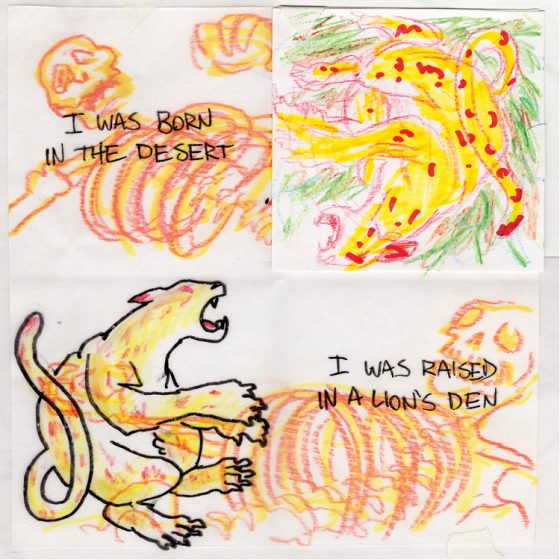Caleb Orecchio here with thoughts on Trench Dogs by Ian Densford
———————————————————————————————

What a monstrous dream Ian Densford has conceived. His new graphic novel, Trench Dogs (which originally ran on on the Comics Workbook Tumblr in a different incarnation), left me sitting and blinking and thinking about what I’d read in quiet contemplation. The book is a series of alternating accounts of World War I told as a continuum in a 3-panel-per-page meter. With an omniscient eye and no regard for the faint of heart, we are swept through the perils of The Great War and witness the utter destruction of sixteen million people. Densford does however depict these people as “funny” animals which keeps the visual horror at arms length and digestible; but despite the “Maus-ian” approach, and like Maus, the pain of the events depicted retain their power.
Trench Dogs is obviously influenced by Art Spiegelman’s Maus. This is an easy observation due to the “Roll Call” page preceding the story in which each nationality therein is labeled and depicted as their respective animal avatar, but I see a handful of other and possibly more vital influences or comparable works. The first and most important to me is Suiho Tagawa. Most savvy American readers will remember his war comic Norakuro from Kramers 6. When I first saw that Trench Dogs was 3-panels per page I could not stop thinking of Norakuro. Plus, unlike Maus, both Trench Dogs and Norakuro allow for whimsy. Trench Dogs is mostly not very funny, but there are moments of “cartoony” bliss that fall through the bleak cracks and relieve the senses of the total desolation burdening the bulk of the book.
Similarly, Hayao Miyazaki’s manga Tiger Im Schlamm blends war (specifically tank battles in WWII) with the cartoony anthropomorphized soldier. And like Tiger Im Schlamm, Trench Dogs is rendered in watercolor. Though not quite done justice by the book’s glossy paper, (I am generally underwhelmed by the production choices of Dead Reckoning – the publisher) the paints give vibrance to the story and, again, cast a little light on the dark subject of WWI.
And I would be remiss to not mention Joe Sacco’s panorama huge foldout illustration, The Great War, as an influence. I would lay money down right now that The Great War was a major influence for Densford.
The real key to Trench Dogs is the steady and uninterrupted 3-panel grid (Yes yes – this is Comics Workbook and we love grids). Densford keeps perfect timing with the grid. Every panel carries the same weight so the pace is consistent throughout the entire comic. He makes good use of the middle of the page and, as I read, I noticed I would let myself wander around the spread. Sometimes I read the first tier on the left page to the tier on the right without reading the other two panels on the left, and to my pleasant surprise it did not affect the reading. Sometimes I would look at the middle panel first, and then “spiral” out. It all still made sense. This is high praise. Being a student of Frank Santoro’s, I can’t help but assume that Densford’s way of using layouts was conscious and not a fluke.
The fact that Trench Dogs is essentially wordless aids in this amorphous way of reading. The reader is not locked onto a stream of dialogue that guides the action around the spread. We are free to see what we see without the confines of conversation or narration.
The story itself is incredibly poignant and quite vicious. It is a war story or a story of a war. It does not pretend to do anything other than depict war and war’s violent consequences. Page after page, the reader is bombarded with terrifying realities of actual events. The rhythm of the constant chaos and depravity, 1-2-3 1-2-3 1-2-3 1-2-3, starts to mess with you. After a while, you forget you are looking at drawings of animals and eventually you accept these images as the actual events they depict.
There is little catharsis in reading Trench Dogs. I was quite shocked at the end when (no spoilers) after the war is over and medals are awarded, the violence continues back on our own soil completely separate and tangential from the war “over there.”
Still, there is wisdom in this book in its depiction of human suffering, selfishness, selflessness and survival. Ian Densford steps back and triangulates the brutality of a war that laid waste to an entire continent and more as we stare in horror and amazement hoping we never share their fate, and yet it is difficult not to sympathize and even admire the victims whoever they might be. Death is the great equalizer and, when people encounter it, we can learn a lot from that. Ian Densford has masterfully managed to encapsulate that fact into a comic book.
———————————————————————————————
You can buy Trench Dogs directly from the publisher here.
OR if you want to buy Trench Dogs directly from Ian, you can attend these shows on the following dates:
– New York Comic Con, October 4-7
